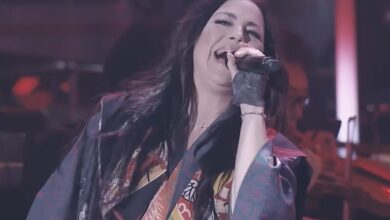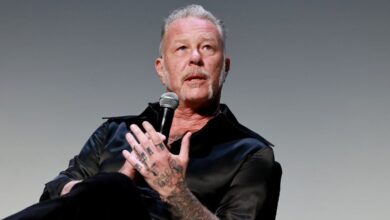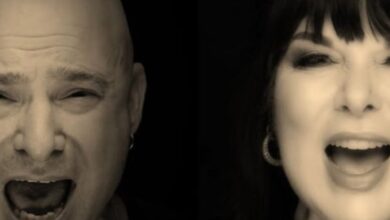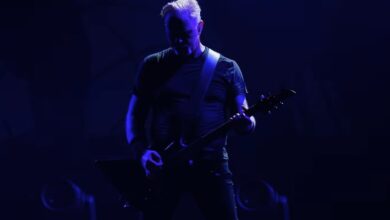James Hetfield’s Emotional “Fade to Black” Speech from Adelaide Finally Surfaces Online
On November 5, 2025, Adelaide Oval stopped being a cricket ground and briefly became a cathedral for riffs, memories, and a very real conversation about staying alive. Metallica’s M72 World Tour rolled into town after more than a decade away, and around 50,000 fans poured into the venue for what was billed as a career-spanning, in-the-round stadium event. No one knew that the night’s emotional peak wouldn’t be a pyro blast or a shred solo, but a quiet moment before “Fade to Black” when James Hetfield decided to talk—really talk—about suicide, pain, and the stubborn act of holding on.
Well before the first chord rang out, the entire precinct around the Oval buzzed like a pre-game final. Merch queues snaked past food stalls, parents in weathered tour shirts compared memories from 1991 and 2010 while their teenage kids excitedly checked setlist sites on their phones. This show carried extra meaning for Adelaide: the band had canceled a planned 2019 visit when Hetfield entered rehab, so this felt like unfinished business finally being settled. As the sun dropped behind the stands and the November heat softened into a warm evening, it was obvious the city had turned out not just for nostalgia, but to see if their metal heroes still had something new to say.
At the center of the pitch, the M72 stage looked more like a sci-fi structure than a traditional rock platform. The band’s now-signature 360-degree layout put the drum riser, mic stands, and ramps in a ring, surrounded by the crowd on all sides. Four towering video monoliths rose above, ready to flip from live close-ups to bold graphics in an instant. For fans in the nosebleeds, the screens meant every grimace, every down-pick, every smile would be visible; for those in the Snake Pit, the band would spend the night practically brushing their fingertips. The message was clear: there would be no “back row” tonight—only different vantage points on the same shared storm.
The ritual began with AC/DC’s “It’s a Long Way to the Top (If You Wanna Rock ’n’ Roll)” pumping through the PA, a nod to Australian rock heritage that instantly loosened up the stands. Then came the spine-tingler: Ennio Morricone’s “The Ecstasy of Gold,” Metallica’s walk-on music for decades, rolled across the Oval as cameras picked out faces in the crowd. When the four members strode onto the circular stage—Hetfield in his familiar black, Lars Ulrich bounding to the kit, Kirk Hammett cradling his guitar like a weapon, Robert Trujillo pacing like a coiled spring—the roar that met them rattled the grandstands. Before they’d played a note, the show already felt huge.
They opened with “Creeping Death,” a time-tested way to turn a stadium into a seething chant factory. By the “Die! Die!” section, the Oval was already a choir. “For Whom the Bell Tolls” followed, its lumbering groove and tolling bass sending vibrations up through the seats. The in-the-round stage proved its worth immediately: as the band rotated positions, each quadrant of the crowd got its own “front-row” minute, phones shooting shaky footage from every angle. The sound was big but surprisingly clear—cymbals shimmering rather than hissing, guitars slicing instead of mudding out. Whatever doubts anyone had that these guys could still command a stadium evaporated by the time the second chorus hit.
Then came the first “I can’t believe they’re playing this” moment. The jagged opening riff of “Leper Messiah” coughed out of Hetfield’s guitar, and a visible ripple of recognition moved across the die-hards. This wasn’t a Black Album staple: it was a Master of Puppets deep cut that doesn’t always make the big-room setlists. In Adelaide, though, it landed like a gift. Older fans who’d worn out their cassette copies in the ’80s roared in delight; younger ones quickly locked into the groove, headbanging as if they’d been waiting for it their whole lives. The song’s cynical bite at manufactured idols felt weirdly timely, and hearing it roar out of a modern stadium PA underlined just how little its teeth have dulled.
“King Nothing” kept the theme of toppling false crowns going, stomping across the Oval on that big, bouncy mid-’90s riff. By now the band had settled into that relaxed, dangerous groove they find on good nights—tight but loose, joking between themselves as they criss-crossed the stage. Between songs, Hetfield bantered with the crowd, commenting on how long it had been since they’d hit Adelaide and grinning at the sight of “more grey hairs and more kids” in the same audience. It was the classic Metallica trick: they were the headliners of a gigantic tour, but they spoke like a bar band grateful to still be invited back.
Then the lights dropped into a cooler blue, and everything changed. The first arpeggiated notes of “Fade to Black” drifted out, delicate and almost fragile after the crush of the previous songs. Instead of barreling straight into the verse, Hetfield stepped up to the mic and stopped the momentum cold. He told the crowd, in a low, steady voice, that this song from 1984 was about suicide—about the darkest thoughts people have but rarely admit. He urged anyone feeling that way not to disappear, but to reach out, to talk, to “please wait.” Then came the line that stuck with people: a reminder that they were not alone, shouted not as a slogan, but as someone who’s clearly been through his own nights of staring into the abyss.
For a band often associated with volume and aggression, the silence during that speech might have been the loudest sound of the night. Tens of thousands of people stood almost perfectly still, the usual chatter dying down to a hush. You could see fans nodding in recognition, some with arms around each other’s shoulders, others wiping at their eyes with the back of a hand. Hetfield’s words carried extra weight knowing his long-public battles with addiction and mental health; this wasn’t a rock star playing therapist, it was a survivor extending a hand from the stage. In a world where heavy music is still lazily blamed for glamorizing darkness, here was one of its biggest icons saying the opposite: you can talk about the worst thoughts you’ve had and still choose life.
When the band finally slid into “Fade to Black” properly, the song felt different—not just a melancholic classic, but a living conversation. The early verses moved slowly, nearly drowned out by the stadium-sized sing-along as fans took over the lyrics. Phone lights blossomed across the Oval like tiny constellations, giving the impression that the band were playing under their own private galaxy. As the arrangement grew heavier, the emotional temperature climbed with it. Hammett’s solos reached for the rafters, bending and screaming in that way only he can, while Lars kicked the ending double-bass section with renewed ferocity, as if trying to punch holes in the darkness Hetfield had just named.
In the stands, the performance landed like a collective exhale. Later, fans would write online about how they’d grown up clinging to “Fade to Black” through breakups, depressive episodes, and lonely years, and how hearing it prefaced with an explicit message of hope felt like something closing a long-open loop. Parents squeezed their kids a little tighter, old friends exchanged knowing looks, and strangers who’d never speak again found themselves singing the same chorus into the night. For some, that four or five minutes of music and talk probably did more than a motivational poster or a throwaway hashtag ever could.
Of course, this was still a Metallica stadium show, and the band knew not to leave the crowd suspended in that heavy emotional space forever. Almost as a deliberate shock to the system, “Fuel” came roaring out next, its opening “Gimme fuel, gimme fire!” line acting like a defibrillator on the Oval. Flames flared from the stage edges, the tempo shot back into the red, and people who’d been quietly swaying moments earlier were suddenly jumping, shouting, and laughing again. It was a smart piece of setlist architecture: acknowledge the darkness, give people a place to put it… and then flood the room with adrenaline.
From there, the show threaded that needle between catharsis and celebration with almost ridiculous ease. “The Day That Never Comes” stretched out in widescreen, shifting from its mournful intro into churning, militaristic riffs that made the entire stadium feel like a single, marching organism. “Moth Into Flame” blasted a warning siren over social-media addiction, its spiraling guitars and rapid-fire vocals reflected in frantic light patterns on the towers above. “Sad but True” landed like a slow-motion wrecking ball, the kind of viscous groove that feels physically heavier in a big open-air setting. The memory of Hetfield’s earlier words about suicide floated over all of it, adding an extra dimension to songs already steeped in struggle and survival.
When “Nothing Else Matters” arrived, the Oval turned into a massive, slightly off-key choir again. The song’s familiar finger-picked intro drew instant cheers, but there was a softness to the way the verses were sung that suggested a crowd still mulling over what they’d heard earlier. Couples hugged, mates swayed together, and the field glowed under phone lights and stage beams in a way that felt strangely intimate for such a huge space. Then “Seek & Destroy” blew that tenderness to smithereens, pulling mosh pockets back into existence and reminding everyone that as much as Metallica can make you think and feel, they’re also very, very good at making you lose your mind.
The closing double-hit of “One” and “Master of Puppets” was pure spectacle. Machine-gun lights stuttered in time with Lars’ kick patterns during “One,” turning the stage into a war-zone diorama as the song’s anti-war narrative played out in front of 45,000 people. “Master of Puppets,” turbo-charged by its pop-culture revival, turned into a generational collision: Gen X fans who’d worn out vinyl copies as teenagers yelling side by side with kids who discovered it via Stranger Things. Yet even at peak chaos, there was a sense that this wasn’t just about riffs—it was about endurance, about a band and a fanbase that have both survived their share of bad nights and lived to scream another chorus.
Once the house lights finally came up and the band took their bows, Adelaide Oval looked like the aftermath of some joyful storm. People shuffled toward the exits with that dazed, happily wrung-out expression only truly great shows produce. Snatches of conversation floated in the warm night air: arguments about the best song of the evening, praise for the deep cuts, jokes about sore necks in the morning. Over and over, one moment kept coming up—Hetfield’s speech and “Fade to Black.” The pyrotechnics, the rare songs, the huge production were all loved, but that quiet, vulnerable pause in the middle of the set had somehow become the gravitational center of the night.
Within hours, clips from the show started bouncing around social media. Fan-shot videos of Hetfield talking about suicide, finishing with a firm “you are not alone,” spread fast, often reposted with captions from people sharing their own battles. Other edits stitched together those lines with his earlier statements about “Screaming Suicide” and the idea that if it’s a human experience, we should be able to talk about it. For a band once accused of writing a “dangerous” song in “Fade to Black,” it was poetic justice: the same song now serving as a lifeline instead of a scapegoat.
In the end, what made November 5, 2025 in Adelaide special wasn’t just that Metallica proved they can still bulldoze a stadium four decades into their career. It was that they managed to balance thunder and tenderness, speed and stillness, spectacle and sincerity without dropping the thread. “Leper Messiah” thrilled the lifers, “Lux Æterna” showed they’re still writing future classics, and the closing barrage reminded everyone why their logo belongs on the Mount Rushmore of metal. But it was “Fade to Black,” framed by a simple, honest speech about not giving up, that turned a great concert into something more. For thousands standing under the lights at Adelaide Oval, that moment made the difference between just having seen Metallica and having shared something with them—and that’s the kind of night you don’t easily forget.





